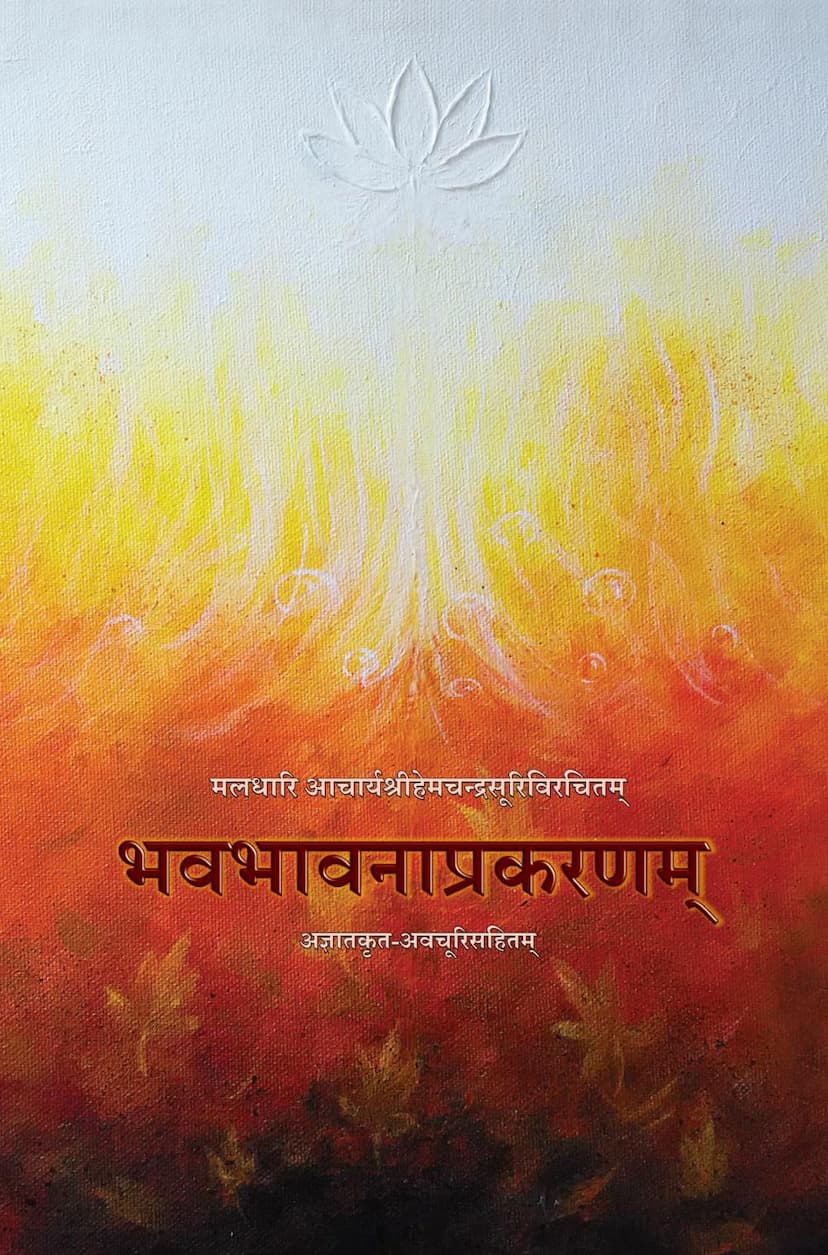Bhavbhavna Prakaranam
Added to library: September 1, 2025

Summary
This comprehensive summary is based on the provided Jain text, "Bhavbhavna Prakaranam" by Acharya Hemchandracharya, with an unknown commentator (Avachurakarta), and edited by Muni Vairagyarativijay Ganivar.
Title: Bhavbhavna Prakaranam (with Avachuri)
Author: Acharya Hemchandracharya (Maladharagachchhiya)
Commentator: Unknown
Chief Editor: Muni Vairagyarativijay Ganivar
Publisher: Shrutbhuvan Sansodhan Kendra, Pune (Shubhabhilasha Trust, Ahmedabad)
Subject: Instruction/Guidance (Upadesh)
Core Theme: The Bhavbhavna Prakaranam is a text focused on detachment (Vairagya) and teaches the twelve bhavanas (reflections/contemplations). It elaborates on the concept of 'Bhavbhavna' (contemplation of the cycle of existence), with a particular focus on the nature of the worldly existence and the suffering inherent within it.
Key Aspects and Content:
-
Attribution and Commentary: The text is attributed to the renowned Maladharacharya Shri Hemchandracharya. It includes an "Avachuri" (commentary) by an unknown author, which provides explanations and elaborations on the original verses. The work was edited by Muni Vairagyarativijay Ganivar.
-
Purpose of the Work: The Bhavbhavna Prakaranam aims to provide guidance and instruction to individuals, particularly those seeking spiritual liberation. It emphasizes understanding the impermanent and suffering-filled nature of worldly existence to foster detachment and encourage the pursuit of Dharma.
-
The Twelve Bhavanas: The core of the text is the contemplation of twelve Bhavanas:
- Anitya (Impermanence): Contemplation of the transient nature of all things in the universe, including life, the body, wealth, and even celestial realms. The text uses analogies like children playing with sandcastles to illustrate this impermanence.
- Aśaraṇa (Lack of Refuge): Reflecting on the fact that in times of suffering, disease, old age, or death, there is no true refuge or support except the teachings of the Jinas (Jain Tirthankaras). It highlights how even powerful beings and possessions cannot offer lasting protection.
- Ekatva (Oneness/Solitude): Understanding that ultimately, one is alone in experiencing the consequences of their actions (karma). Birth, death, and the journey to the next life are individual experiences.
- Anyatva (Otherness): Realizing that one's body, family, wealth, and all worldly possessions are separate from the true self (soul). These are external and do not accompany the soul in its transmigration.
- Bhavbhavna (Cycle of Existence): This is a central theme, detailing the nature of existence across different realms (hellish beings, animals, humans, celestials) and the suffering associated with each.
- Naraka Bhav (Hellish Existence): Vivid descriptions of the seven hells, their inhabitants, their suffering, the immense heat and cold, the horrific environments, and the torment inflicted by demonic beings. The text details the types of beings, the structure of hellish realms, and the karmic retribution experienced there.
- Tiryak Gati (Animal Realm): Descriptions of the suffering of animals, including their vulnerability to external forces, their natural tendencies towards conflict, their exploitation by humans, and their experiences of birth, death, and rebirth in various forms.
- Manushya Gati (Human Realm): An exploration of the human condition, covering the stages of life (in the womb, childhood, youth, old age), the suffering associated with each, the fleeting nature of youth and fortune, and the difficulties faced by the poor and the virtuous alike. It also details the development of the human body in the womb and the inherent impurities.
- Dev Gati (Celestial Realm): While describing the blissful existence of celestials in their opulent abodes, the text also hints at their eventual downfall due to the exhaustion of their good karma and the rise of envy and dissatisfaction when comparing themselves to others.
- Aśuchitva (Impurity): Contemplating the physical impurity of the body, its composition of blood, flesh, bones, and excretions, and realizing that true purity lies in spiritual discipline, not external cleanliness.
- Loka Swabhava (Nature of the Universe): Understanding the impermanence and constant flux of the universe, including the changing relationships between beings and the cyclical nature of creation and destruction.
- Āśrava (Influx of Karma): Identifying the channels through which karmas bind the soul, such as passions (kashayas - anger, pride, deceit, greed), senses, and actions stemming from ignorance and attachment.
- Samvara (Cessation of Karma): The means to stop the influx of new karmas, primarily through controlling the senses, managing passions, and cultivating virtuous thoughts and actions.
- Nirjara (Shedding of Karma): The process of eliminating accumulated karmas through austerities, penance, meditation, knowledge, and virtuous conduct.
- Guṇaratna (Jewel-like Qualities): Reflecting on the virtues and qualities of the enlightened beings (Jinas, Siddhas, spiritual leaders) and aspiring to cultivate them.
- Bodhi (Enlightenment): Contemplating the rarity and preciousness of attaining right faith, right knowledge, and right conduct, which ultimately lead to liberation.
-
Illustrative Narratives (Kathas): The text is rich with stories and examples (kathas) to illustrate the principles of each Bhavana. These stories often depict the consequences of actions, the impermanence of worldly pleasures, and the suffering resulting from negative tendencies, thereby reinforcing the intended message of detachment.
-
Emphasis on Knowledge and Conduct: Throughout the text, there is a strong emphasis on the importance of right knowledge (Jnana) and right conduct (Charitra) as the means to understand these Bhavanas and ultimately achieve liberation.
-
Scholarly Edition: The publication by Shrutbhuvan Sansodhan Kendra, Pune, suggests a scholarly effort to preserve and disseminate ancient Jain texts, potentially including critical editing and comparative analysis of manuscripts. The inclusion of an Avachuri indicates the effort to make the text accessible to a wider audience.
In essence, Bhavbhavna Prakaranam serves as a profound guide for spiritual aspirants, systematically dissecting the nature of suffering in worldly existence and prescribing the path of knowledge, conduct, and contemplation of the Bhavanas as the means to achieve liberation from the cycle of birth and death.